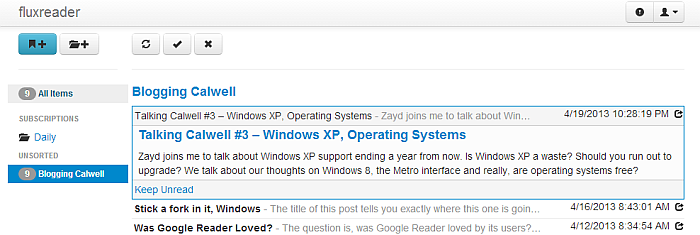First Look: FluxReader – An RSS Reader
With Google Reader’s demise now just around the corner, I’ve been actively looking for a replacement feed reader that can handle the kind of volume Google did. This is really no easy task because most of the feed readers today exist to make the feed look pretty, not improve efficiency I’ve recently settled into TT-RSS, but have been open to finding that one RSS reader that suits my needs perfectly. Today, an invite came in for a new reader called FluxReader. While this is still in beta, and much will likely change, I wanted to get a good feel for whether this tool could be a worthy Google Reader replacement.
And, sometimes you just know right away. I see promise with FluxReader, but it wouldn’t replace Google Reader just yet. With FluxReader, the entire interface is sparse, and that’s generally a good thing. There are only two buttons presented along the top-left of the interface that is for adding a feed and adding a folder. The settings themselves really only include the ability to import OPML lists, with an explanation for getting this from Google Reader. I’m sure a number of settings will be added in the future.
Adding a feed is very simple (just supply a URL, such as https://cwl.cc/feed). What was frustrating after adding a subscription was the delay I showing the new feed on the interface. Flux Reader took a good few minutes to reflect that a new feed had been added, and continued refreshes of the interface didn’t provide the feed list (or details about progress). After a short time, the feed appeared and I could go through unread items. I would expect this process to be more painful if I had a full 150 feeds in FluxReader, so providing more visual information about this progress or that a new feed had been added would help with this.
I do like the look of FluxReader. It’s simple, clean and feels like it makes good use of space on the screen. When an article is opened, a small preview is visible and the article can be followed if you want to read more.
That type of thing really does lend itself to the overall speed of the process, but one glaring omission is the lack of keyboard shortcuts. I hope the plan is to add (at the very least), the basic Google Reader standardized shortcuts like N, M, V, O and perhaps expand from that. One of the most important things about Google Reader’s speed was using the keyboard to move through items fast and mark them as read.
FluxReader has something here. It’s clean simple and looks better than most, even if it does remind me a bit of The Old Reader. While I wouldn’t switch to this right now, I’m looking forward to seeing how this tool evolves.
FluxReader is currently in an invite-only beta. Request your invitation here. This first look article was based on version 0.3.4 of FluxReader.



